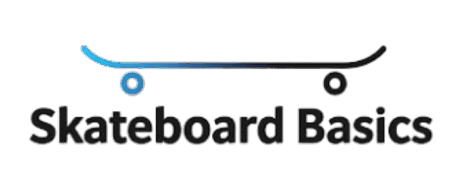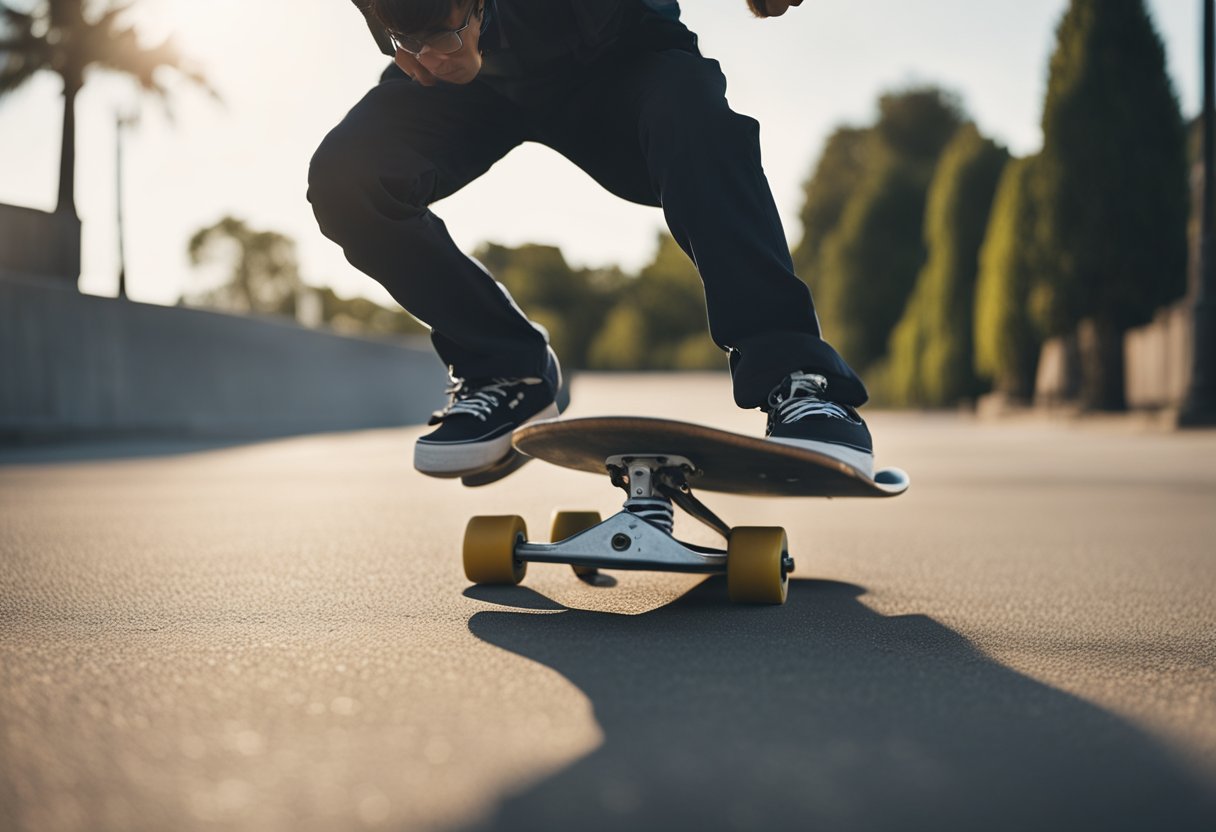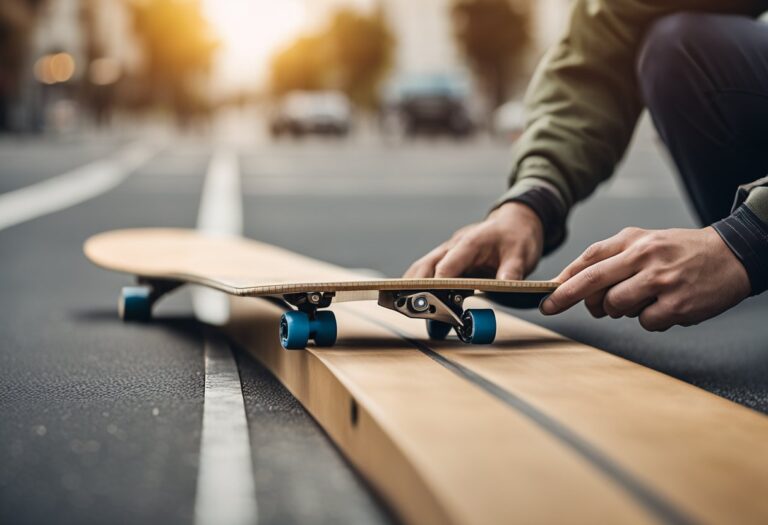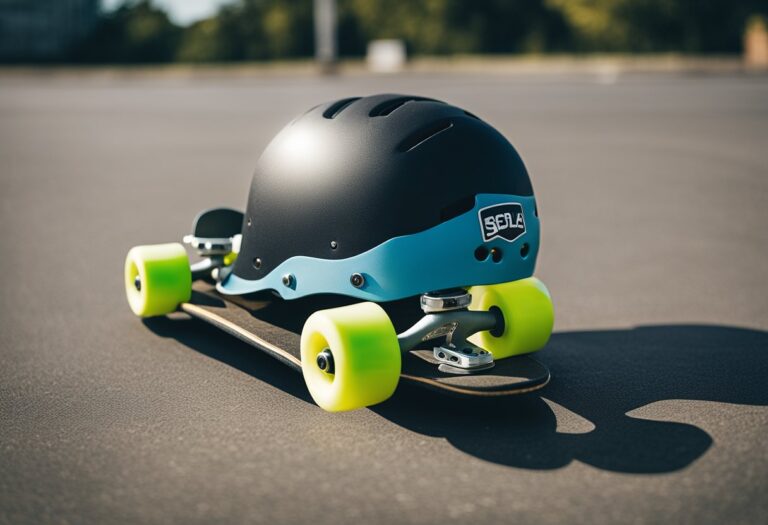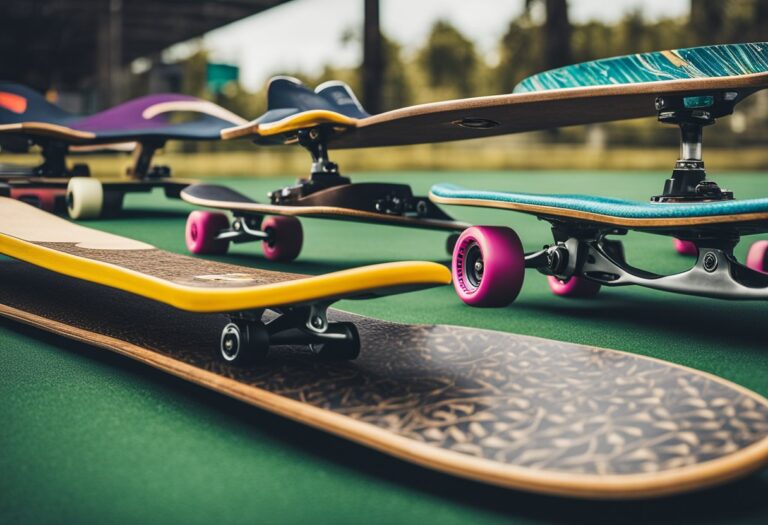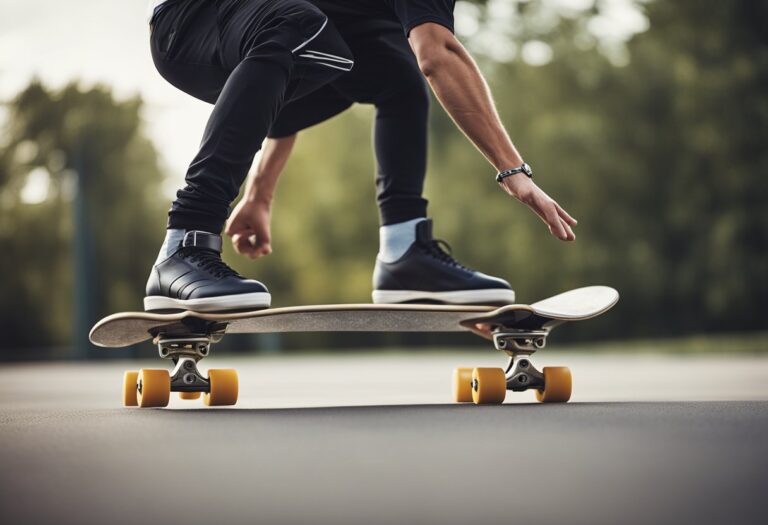Starting Skateboarding: Tricks, and Safety Precautions for Beginners
Skateboarding is a fun and exciting activity that has been enjoyed by people of all ages for decades. It is a great way to stay active and challenge yourself physically and mentally. However, as with any sport, it is important to take the necessary precautions and learn the fundamentals before diving in headfirst. In this article, we will provide tips, tricks, and safety precautions for beginners looking to start skateboarding.

Choosing the right skateboard is crucial for beginners. There are many different types of skateboards available, each with its own unique features and benefits. It is important to consider factors such as deck size, wheel hardness, and truck width when selecting a skateboard. Additionally, beginners should invest in safety gear such as a helmet, knee pads, and wrist guards to prevent injuries while learning.
Once you have chosen your skateboard and safety gear, it is time to learn the fundamentals of skateboarding. This includes proper stance, pushing, turning, and stopping. With practice, beginners can move on to more advanced techniques such as ollies and kickflips. It is also important to understand skatepark etiquette and how to properly maintain your skateboard. By following these tips and tricks, beginners can safely and confidently start their skateboarding journey.
Key Takeaways
- Choosing the right skateboard and safety gear is crucial for beginners
- Learning the fundamentals of skateboarding is essential before attempting more advanced techniques
- Proper skatepark etiquette and maintenance are important for safe and enjoyable skateboarding
Choosing Your Skateboard

Skateboarding can be a thrilling and fun activity, but choosing the right skateboard is crucial for beginners. A skateboard that is too big or too small can make it difficult to learn and can even be dangerous. In this section, we will discuss the different types of skateboards, how to understand skateboard sizes, and how to select the right components.
Types of Skateboards
There are three main types of skateboards: street, cruiser, and longboard. Street skateboards are the most common type and are designed for tricks and stunts. Cruiser skateboards are larger and more stable, making them ideal for cruising around town. Longboards are the longest and most stable type of skateboard and are designed for downhill riding and cruising.
Understanding Skateboard Sizes
Skateboard sizes are measured in inches and are based on the length and width of the deck. The length of the deck ranges from 28 to 32 inches for street skateboards and up to 44 inches for longboards. The width of the deck ranges from 7 to 8.5 inches for street skateboards and up to 10 inches for longboards.
Selecting the Right Components
When selecting components for your skateboard, it is important to consider the quality and durability of the parts. The components include the trucks, wheels, bearings, and grip tape. The trucks are the metal parts that attach the wheels to the deck, and they come in different sizes to match the width of the deck. The wheels come in different sizes and hardness levels, with softer wheels being better for cruising and harder wheels being better for tricks. The bearings are the small metal balls that allow the wheels to spin, and they come in different grades of quality. The grip tape is the rough, sandpaper-like material that covers the top of the deck and provides traction for your feet.
Overall, choosing the right skateboard is essential for beginners. By understanding the different types of skateboards, skateboard sizes, and components, beginners can select a skateboard that is safe, comfortable, and suited to their individual needs.
Safety Gear and Equipment

Essential Protective Gear
Skateboarding can be a fun and thrilling activity, but it also comes with its fair share of risks. To minimize the chances of injury, it is crucial to wear the right safety gear. Here are some essential protective gear that every beginner skateboarder should have:
- Helmet: A helmet is the most important piece of safety gear. It protects the head from serious injuries in case of a fall or collision. It is recommended to wear a helmet that meets safety standards like ASTM F1492 or CPSC.
- Knee and Elbow Pads: Knee and elbow pads protect the joints from scrapes, cuts, and bruises. They also provide cushioning in case of a fall. It is advisable to wear pads that fit snugly and do not move around.
- Wrist Guards: Wrist guards are essential for protecting the wrists from fractures and sprains. They also provide support and stability to the wrists. It is recommended to wear wrist guards that have a hard shell and adjustable straps.
Additional Safety Accessories
Apart from the essential protective gear, there are some additional safety accessories that can further enhance the safety of a beginner skateboarder:
- Shoes: Skateboarding shoes should have a flat and grippy sole that provides good traction on the board. They should also have a padded collar and tongue for comfort and support.
- Gloves: Gloves protect the hands from abrasions and cuts. They also provide a better grip on the board and prevent blisters.
- Reflective Clothing: Reflective clothing makes the skateboarder more visible to motorists and other pedestrians, especially during low-light conditions. It is advisable to wear reflective clothing if skateboarding at night or in dimly lit areas.
By wearing the right safety gear and equipment, a beginner skateboarder can minimize the risk of injuries and enjoy the activity with confidence.
Fundamentals of Skateboarding

Skateboarding requires a combination of balance, coordination, and skill. As a beginner, it is important to focus on mastering the fundamentals of skateboarding before attempting more advanced tricks. This section will cover the basic techniques that every beginner should know.
Stance and Balance Basics
The first step in learning to skateboard is to find your stance. Most skaters are either regular-footed (left foot forward) or goofy-footed (right foot forward). To determine your stance, stand with your feet together and have a friend give you a gentle push from behind. The foot you step forward with to catch your balance is your front foot.
Once you have determined your stance, it is important to practice your balance. Stand on your skateboard with your feet shoulder-width apart and your knees slightly bent. Keep your weight evenly distributed between your front and back foot. Practice shifting your weight from your front foot to your back foot and back again.
Starting and Stopping
Before attempting to ride your skateboard, it is important to learn how to start and stop safely. To start, place your front foot on the board and push off with your back foot. Keep your weight over your front foot and use your back foot to steer. To stop, drag your back foot on the ground behind you.
Turning Techniques
Turning is an essential skill for any skateboarder. To turn, lean in the direction you want to go and use your toes and heels to guide the board. For sharper turns, you can use your shoulders to help initiate the turn. Practice turning in both directions to improve your balance and coordination.
By mastering these fundamental techniques, beginners can build a strong foundation for more advanced skateboarding skills. Remember to always wear appropriate safety gear and practice in a safe, controlled environment. With practice and dedication, anyone can become a skilled skateboarder.
Basic Skateboarding Tricks

Skateboarding is not only about cruising around, but also about performing tricks. Here are a few basic skateboarding tricks that beginners can start practicing:
Ollie
The Ollie is the most fundamental skateboarding trick. It involves popping the tail of the skateboard and sliding the front foot up towards the nose to level the board in the air. A good Ollie requires practice and timing. It is important to keep the shoulders parallel to the board and to jump straight up in the air.
Manual
A manual is a trick where the skateboarder balances on the back wheels while rolling forward. It requires a lot of balance and control. To perform a manual, the rider needs to shift their weight towards the back of the board while keeping the front wheels off the ground. It is important to keep the knees slightly bent and to use the arms to maintain balance.
Kickturn
A kickturn is a basic turning maneuver that involves lifting the front wheels off the ground and pivoting the board on the back wheels. It is a useful trick for changing direction or avoiding obstacles. To perform a kickturn, the rider needs to shift their weight towards the back of the board while turning the shoulders in the desired direction.
Pop Shove-it
A Pop Shove-it is a trick where the rider pops the tail of the skateboard and spins it 180 degrees while jumping in the air. It requires a combination of timing, pop, and scoop. To perform a Pop Shove-it, the rider needs to pop the tail of the board and scoop the back foot to spin the board. It is important to keep the front foot over the board and to jump straight up in the air.
Remember, practice makes perfect. Always wear protective gear and start with the basics before moving on to more advanced tricks. With dedication and patience, anyone can become a skilled skateboarder.
Skatepark Etiquette

Skateparks can be exciting and intimidating for beginners. To ensure a safe and enjoyable experience for everyone, it’s important to follow proper skatepark etiquette. Here are some tips to help beginners navigate the skatepark:
Navigating the Skatepark
Before entering the skatepark, take a moment to observe the flow of skaters. Skateparks have a natural flow, and it’s important to follow it to avoid collisions. Start by skating in the less crowded areas and work your way up to the more challenging sections.
When waiting for your turn, stand off to the side of the skatepark and be aware of your surroundings. If you see someone approaching, be sure to yield the right of way and allow them to pass.
Respecting Other Skaters
Skateparks are a shared space, so it’s important to be respectful of other skaters. Avoid cutting in front of other skaters or hogging a particular section of the park. Take turns and share the space with others.
If you see someone struggling with a trick, offer encouragement and support. Remember, everyone starts as a beginner, and we all have to learn and progress at our own pace.
Understanding Skatepark Flow
Skateparks have a natural flow, and it’s important to understand it to avoid collisions. The flow of the park is typically from the shallow end to the deep end, and from left to right. Be aware of skaters coming from different directions and adjust your speed and direction accordingly.
When dropping in on a ramp or bowl, be sure to wait for your turn and announce your intentions. This will help other skaters know when it’s safe to drop in and avoid collisions.
By following these tips, beginners can have a safe and enjoyable experience at the skatepark. Remember to always wear proper safety gear, including a helmet, and to never attempt tricks beyond your skill level.
Maintenance and Upkeep

Cleaning Your Skateboard
Keeping your skateboard clean is important for both its longevity and performance. Dirt and debris can accumulate on the bearings and wheels, causing them to slow down and wear out faster. To clean your skateboard, start by removing the wheels and bearings. Use a soft-bristled brush to scrub the dirt off the deck, trucks, and wheels. For stubborn stains, use a mild soap and water solution. Once everything is clean, dry the parts thoroughly before reassembling them.
Replacing Skateboard Parts
Skateboards are made up of several parts that need to be replaced occasionally to maintain their performance and safety. Here are some common parts that may need replacing:
- Wheels: Over time, skateboard wheels can become worn down or cracked. Replace them when they become too smooth or when the cracks become too deep.
- Bearings: Bearings are what allow the wheels to spin smoothly. If you notice that your wheels are not spinning as well as they used to, it may be time to replace the bearings.
- Trucks: The trucks are the metal parts that attach the wheels to the deck. If your trucks are loose or wobbly, it may be time to replace them.
When replacing parts, make sure to choose parts that are compatible with your skateboard. It’s also important to follow the manufacturer’s instructions when installing new parts. If you’re unsure about how to replace a part, it’s best to take your skateboard to a professional.
Improving Your Skills

Skateboarding is a sport that requires a lot of practice and patience. As a beginner, it is important to understand that improving your skills takes time and dedication. Here are a few tips to help you improve your skateboarding skills.
Practice Routines
One of the best ways to improve your skateboarding skills is to establish a regular practice routine. This can involve setting aside a specific time each day or week to practice your skills. It is important to start with the basics and gradually work your way up to more advanced tricks. You can also break down each trick into smaller parts and practice each part individually before putting them all together.
Learning from Others
Another way to improve your skateboarding skills is to learn from others. This can involve watching videos of professional skateboarders, attending skateboarding clinics or camps, or simply skating with more experienced skateboarders. By observing and learning from others, you can pick up new techniques and gain valuable insights that can help you improve your own skills.
Skateboarding Communities and Resources
There are many online communities and resources available for skateboarders of all skill levels. These can include forums, blogs, and social media groups where you can connect with other skateboarders and share tips and advice. You can also find a wealth of information on skateboarding techniques, equipment, and safety precautions through online resources such as videos, articles, and tutorials.
In conclusion, improving your skateboarding skills takes time, dedication, and practice. By establishing a regular practice routine, learning from others, and utilizing available resources, you can steadily improve your skills and become a more confident and skilled skateboarder.
Frequently Asked Questions

What are the essential safety gears a beginner skateboarder should wear?
Beginner skateboarders should always wear protective gear to prevent injuries. The essential safety gear includes a helmet, knee pads, elbow pads, and wrist guards. A helmet is the most important safety gear as it protects the head from injury in case of a fall. Knee pads, elbow pads, and wrist guards protect other parts of the body from injuries.
How does one choose the right skateboard as a beginner?
Choosing the right skateboard as a beginner is crucial for a good skating experience. The skateboard should be the right size and shape for the rider’s height and weight. A wider board is more stable, while a narrower board is more maneuverable. The wheels should also be the right size and hardness for the type of skating the rider intends to do.
What are the fundamental skateboarding skills that beginners should focus on first?
Beginners should focus on learning the basic skateboarding skills before attempting more advanced tricks. The fundamental skills include pushing, turning, stopping, and riding in a straight line. Once these skills are mastered, beginners can move on to more advanced maneuvers.
Can you provide tips for maintaining balance for those new to skateboarding?
Maintaining balance is crucial for skateboarding. Beginners can improve their balance by keeping their weight centered over the board, keeping their knees bent, and looking straight ahead. Practicing on a flat surface and starting with small movements can also help improve balance.
What are the best practices for beginners to prevent injuries while skateboarding?
Beginners can prevent injuries by wearing protective gear, practicing on a flat surface, and starting with small movements. They should also avoid attempting tricks beyond their skill level and avoid skating in areas with heavy traffic or obstacles.
How often should beginners practice skateboarding to improve effectively?
Consistent practice is key to improving skateboarding skills. Beginners should aim to practice at least a few times a week, gradually increasing the duration and intensity of their practice sessions. It is important to take breaks and rest when necessary to avoid fatigue and injury.
